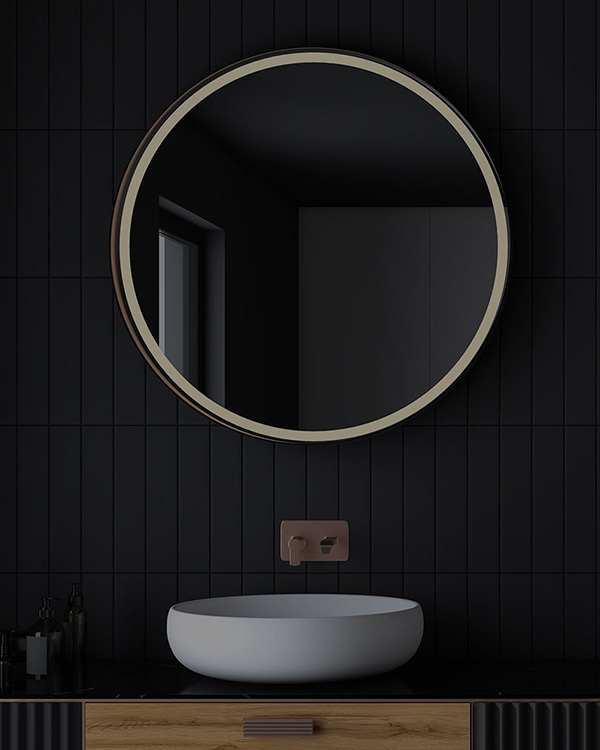Choosing the wrong mirror can ruin your bathroom's ambiance and lighting. A poorly lit space feels dull and uninviting, affecting functionality and aesthetics. Understanding the difference between backlit and lighted mirrors ensures you select the perfect option to enhance your space.
Backlit and lighted mirrors differ in lighting placement and design but share enhanced aesthetics and functional benefits for bathrooms and other spaces.
Deciding between these two types can be challenging. Let’s explore their similarities, differences, and unique benefits to help you make an informed choice.
What Are the Similarities Between Backlit and Lighted Mirrors?
Backlit and lighted mirrors share several features that make them desirable additions to bathrooms and other areas of the home. Both types integrate lighting directly into the mirror’s design, offering convenience and aesthetic appeal.
One key similarity is improved visibility. Both mirrors provide additional lighting that eliminates shadows, making grooming tasks such as shaving or makeup application easier and more precise. Additionally, both options are energy-efficient, often utilizing LED technology that consumes less power while providing long-lasting brightness.
Another shared feature is the modern and sleek aesthetic they bring to a space. Their built-in lighting creates a clean, contemporary look, eliminating the need for separate wall-mounted light fixtures. Both types are also versatile, available in various shapes, sizes, and finishes to suit different interior styles.
Lastly, both mirrors contribute to a clutter-free environment. The integrated lighting reduces the need for extra fixtures, allowing for a streamlined and organized appearance in your bathroom or dressing area.
The Main Distinction Between These Two Lit Mirrors
The primary difference between backlit and lighted mirrors lies in the placement of their light sources. A backlit mirror has LED lights positioned behind the mirror’s surface, creating a soft glow that emanates from the edges. In contrast, a lighted mirror has LEDs embedded in or around the front surface, providing direct illumination.
Backlit mirrors focus on ambient lighting. The soft halo effect they produce enhances the atmosphere of the room, making them ideal for creating a relaxing and spa-like environment. However, this lighting is less focused, meaning it may not be as effective for detailed tasks such as applying makeup.
Lighted mirrors, on the other hand, are designed for functionality. The front-facing lights deliver targeted illumination, reducing shadows on the face. This makes them an excellent choice for grooming activities. Lighted mirrors often feature additional functionalities like dimming options, color temperature adjustments, or integrated touch controls, further enhancing their practicality.
While both types enhance your bathroom's aesthetics, choosing between them depends on your primary need—ambiance versus task lighting.
The Following Are the Benefits of Having a Backlit Mirror
Backlit mirrors offer unique advantages, primarily centered around enhancing the overall ambiance of a space. One of their standout benefits is the soft, diffused light they produce, which minimizes harsh shadows and creates a warm, inviting atmosphere. This makes them perfect for relaxation-focused spaces like bathrooms or bedrooms.
Another benefit is their contribution to a modern and minimalist aesthetic. Backlit mirrors appear to float against the wall, adding a touch of sophistication to any room. They also serve as an excellent decorative element, accentuating textured walls or unique tiling with their gentle glow.
Energy efficiency is another strong suit of backlit mirrors. Using LED technology, they consume less power while offering long-lasting illumination. This not only reduces energy bills but also aligns with sustainable living practices.
Additionally, backlit mirrors often include anti-fog features, ensuring a clear reflection even in steamy bathrooms. Their even distribution of light enhances visibility without overpowering the room’s design.
The Following Are the Benefits of Having a Lighted Mirror
Lighted mirrors excel in functionality, making them a practical choice for bathrooms or dressing areas. Their front-facing lights provide focused illumination, ensuring a clear, shadow-free reflection. This is particularly beneficial for grooming tasks like makeup application, shaving, or hairstyling.
Another advantage of lighted mirrors is their versatility. Many models offer advanced features such as adjustable brightness levels, color temperature control, and touch or motion-activated controls. These functionalities allow users to customize the lighting to suit their specific needs and preferences.
Lighted mirrors also contribute to energy efficiency, with LED lights consuming less power while offering bright, long-lasting illumination. Some designs include additional features such as built-in clocks, Bluetooth speakers, or magnification options, further enhancing their practicality and convenience.
In terms of aesthetics, lighted mirrors add a sleek and modern touch to any space. They eliminate the need for extra lighting fixtures, creating a clean and streamlined look. With various shapes, sizes, and frame options available, lighted mirrors can complement diverse interior styles.
Final Thoughts
Understanding the differences between backlit and lighted mirrors ensures you choose the right one to suit your needs, balancing style and functionality.


